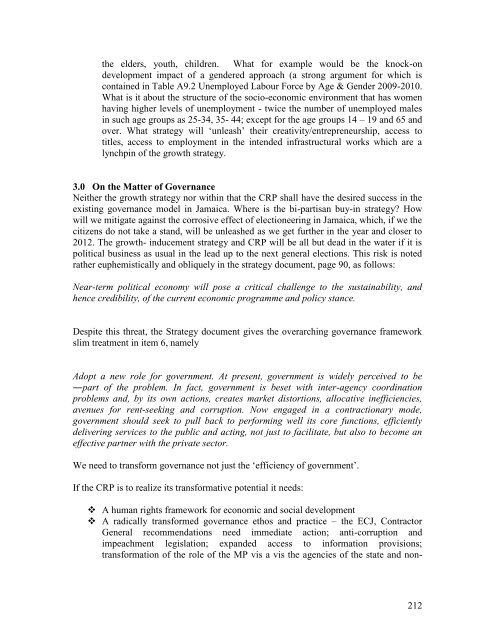PIOJ Growth-Inducement Strategy - Planning Institute of Jamaica
PIOJ Growth-Inducement Strategy - Planning Institute of Jamaica
PIOJ Growth-Inducement Strategy - Planning Institute of Jamaica
You also want an ePaper? Increase the reach of your titles
YUMPU automatically turns print PDFs into web optimized ePapers that Google loves.
the elders, youth, children. What for example would be the knock-on<br />
development impact <strong>of</strong> a gendered approach (a strong argument for which is<br />
contained in Table A9.2 Unemployed Labour Force by Age & Gender 2009-2010.<br />
What is it about the structure <strong>of</strong> the socio-economic environment that has women<br />
having higher levels <strong>of</strong> unemployment - twice the number <strong>of</strong> unemployed males<br />
in such age groups as 25-34, 35- 44; except for the age groups 14 – 19 and 65 and<br />
over. What strategy will ‘unleash’ their creativity/entrepreneurship, access to<br />
titles, access to employment in the intended infrastructural works which are a<br />
lynchpin <strong>of</strong> the growth strategy.<br />
3.0 On the Matter <strong>of</strong> Governance<br />
Neither the growth strategy nor within that the CRP shall have the desired success in the<br />
existing governance model in <strong>Jamaica</strong>. Where is the bi-partisan buy-in strategy? How<br />
will we mitigate against the corrosive effect <strong>of</strong> electioneering in <strong>Jamaica</strong>, which, if we the<br />
citizens do not take a stand, will be unleashed as we get further in the year and closer to<br />
2012. The growth- inducement strategy and CRP will be all but dead in the water if it is<br />
political business as usual in the lead up to the next general elections. This risk is noted<br />
rather euphemistically and obliquely in the strategy document, page 90, as follows:<br />
Near-term political economy will pose a critical challenge to the sustainability, and<br />
hence credibility, <strong>of</strong> the current economic programme and policy stance.<br />
Despite this threat, the <strong>Strategy</strong> document gives the overarching governance framework<br />
slim treatment in item 6, namely<br />
Adopt a new role for government. At present, government is widely perceived to be<br />
―part <strong>of</strong> the problem. In fact, government is beset with inter-agency coordination<br />
problems and, by its own actions, creates market distortions, allocative inefficiencies,<br />
avenues for rent-seeking and corruption. Now engaged in a contractionary mode,<br />
government should seek to pull back to performing well its core functions, efficiently<br />
delivering services to the public and acting, not just to facilitate, but also to become an<br />
effective partner with the private sector.<br />
We need to transform governance not just the ‘efficiency <strong>of</strong> government’.<br />
If the CRP is to realize its transformative potential it needs:<br />
A human rights framework for economic and social development<br />
A radically transformed governance ethos and practice – the ECJ, Contractor<br />
General recommendations need immediate action; anti-corruption and<br />
impeachment legislation; expanded access to information provisions;<br />
transformation <strong>of</strong> the role <strong>of</strong> the MP vis a vis the agencies <strong>of</strong> the state and non-<br />
212
















